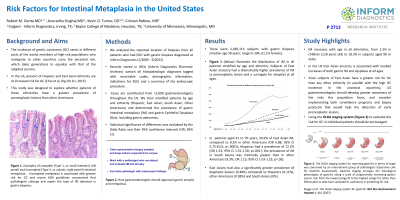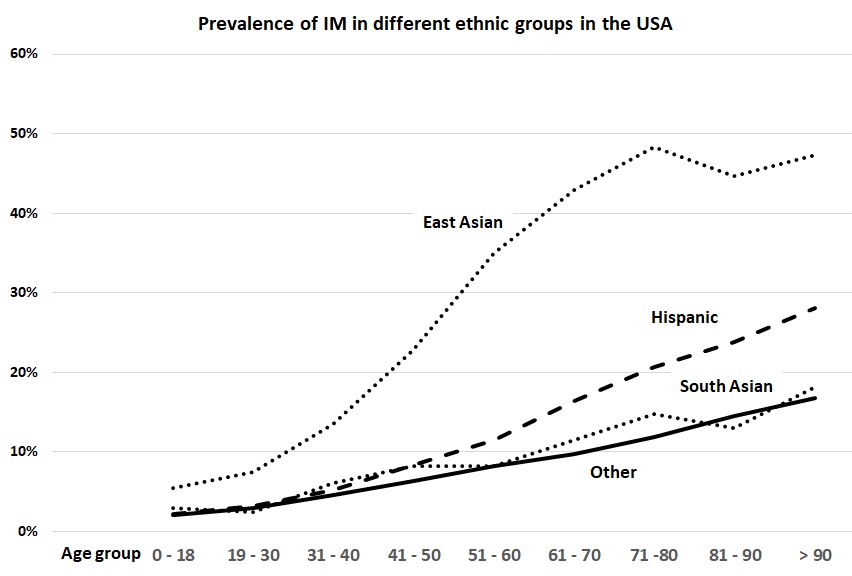Monday Poster Session
Category: Stomach
P2712 - Risk Factors for Gastric Intestinal Metaplasia in the United States
Monday, October 23, 2023
10:30 AM - 4:15 PM PT
Location: Exhibit Hall

Has Audio

Kevin Turner, DO
University of Minnesota
Minneapolis, Minnesota
Presenting Author(s)
Award: Presidential Poster Award
Anuradha Singhal, MBBS1, Kevin Turner, DO2, Cristian Robiou, MD1, Robert M. Genta, MD3
1Inform Dx - Fulgent, Irving, TX; 2University of Minnesota, Minneapolis, MN; 3Baylor College of Medicine, Irving, TX
Introduction: The incidence of gastric carcinoma (GC) varies in different parts of the world; high-risk populations who immigrate to other countries carry the ancestral risk, which takes generations to equalize the adopted country. In the US, persons of Hispanic and East Asian ancestry have increased risk for GC. This study was designed to explore whether patients of these ethnicities have a greater prevalence of preneoplastic lesions than other Americans.
Methods: We analyzed the location of biopsies from all patients who had EGD with gastric biopsies diagnosed at Inform Diagnostics (1/2009 - 9/2022). Records stored in the Inform Diagnostics database (IDEA) contain all histopathologic diagnoses tagged with searchable codes, demographics, indications for EGD, and a summary of the endoscopic procedure. Cases are contributed by >2,000 practitioners throughout the US. We then stratified patients by age and ethnicity and determined the prevalence of gastric intestinal metaplasia (IM) and epithelial dysplasia, including gastric adenomas. Statistical significance was evaluated by the Odds Ratio and their 95% confidence Intervals (OR; 95% CI).
Results: There were 2,036,113 subjects with gastric biopsies (median age 58 years; range 0–104; 61.1% female). Figure 1 illustrates the distribution of IM in all patients stratified by age and ethnicity. Subjects of East Asian ancestry had a dramatically higher prevalence of IM at all ages. In patients aged 41 to 70 years, 34.9% of East Asians had IM,versus 8.3% of other Americans (OR 5.88; 95% CI 5.75-6.01; p< .0001); Hispanics had a prevalence of 12.2% (OR 1.53; 95% CI 1.51-1.58; p< .001); IM in South Asians was minimally greater than in other Americans (9.3%; OR 1.13; 95% CI 1.03-1.23; p< .05). East Asians had a significantly greater prevalence of dysplastic lesions (0.48%) compared to Hispanics (0.11%), other Americans (0.08%) and South Asians (0%).
Discussion: IM increases with age, from 2.2% in children (≤18 years old) to 18.3% in subjects aged >90 years. However, in the US East Asian ancestry is associated with marked increases of both gastric IM and dysplasia at all ages. Since East Asians have a greater risk for GC than any other ethnicity (in parallel with the high GC incidence in the ancestral countries), US gastroenterologists should develop greater awareness of the risks this population faces, and consider implementing both surveillance programs and biopsy protocols that would help the early detection of preneoplastic lesions.

Disclosures:
Anuradha Singhal, MBBS1, Kevin Turner, DO2, Cristian Robiou, MD1, Robert M. Genta, MD3. P2712 - Risk Factors for Gastric Intestinal Metaplasia in the United States, ACG 2023 Annual Scientific Meeting Abstracts. Vancouver, BC, Canada: American College of Gastroenterology.
Anuradha Singhal, MBBS1, Kevin Turner, DO2, Cristian Robiou, MD1, Robert M. Genta, MD3
1Inform Dx - Fulgent, Irving, TX; 2University of Minnesota, Minneapolis, MN; 3Baylor College of Medicine, Irving, TX
Introduction: The incidence of gastric carcinoma (GC) varies in different parts of the world; high-risk populations who immigrate to other countries carry the ancestral risk, which takes generations to equalize the adopted country. In the US, persons of Hispanic and East Asian ancestry have increased risk for GC. This study was designed to explore whether patients of these ethnicities have a greater prevalence of preneoplastic lesions than other Americans.
Methods: We analyzed the location of biopsies from all patients who had EGD with gastric biopsies diagnosed at Inform Diagnostics (1/2009 - 9/2022). Records stored in the Inform Diagnostics database (IDEA) contain all histopathologic diagnoses tagged with searchable codes, demographics, indications for EGD, and a summary of the endoscopic procedure. Cases are contributed by >2,000 practitioners throughout the US. We then stratified patients by age and ethnicity and determined the prevalence of gastric intestinal metaplasia (IM) and epithelial dysplasia, including gastric adenomas. Statistical significance was evaluated by the Odds Ratio and their 95% confidence Intervals (OR; 95% CI).
Results: There were 2,036,113 subjects with gastric biopsies (median age 58 years; range 0–104; 61.1% female). Figure 1 illustrates the distribution of IM in all patients stratified by age and ethnicity. Subjects of East Asian ancestry had a dramatically higher prevalence of IM at all ages. In patients aged 41 to 70 years, 34.9% of East Asians had IM,versus 8.3% of other Americans (OR 5.88; 95% CI 5.75-6.01; p< .0001); Hispanics had a prevalence of 12.2% (OR 1.53; 95% CI 1.51-1.58; p< .001); IM in South Asians was minimally greater than in other Americans (9.3%; OR 1.13; 95% CI 1.03-1.23; p< .05). East Asians had a significantly greater prevalence of dysplastic lesions (0.48%) compared to Hispanics (0.11%), other Americans (0.08%) and South Asians (0%).
Discussion: IM increases with age, from 2.2% in children (≤18 years old) to 18.3% in subjects aged >90 years. However, in the US East Asian ancestry is associated with marked increases of both gastric IM and dysplasia at all ages. Since East Asians have a greater risk for GC than any other ethnicity (in parallel with the high GC incidence in the ancestral countries), US gastroenterologists should develop greater awareness of the risks this population faces, and consider implementing both surveillance programs and biopsy protocols that would help the early detection of preneoplastic lesions.

Figure: Fig. 1 - Prevalence of Intestinal Metaplasia (IM) in different ethnic groups in the United States
Disclosures:
Anuradha Singhal indicated no relevant financial relationships.
Kevin Turner indicated no relevant financial relationships.
Cristian Robiou indicated no relevant financial relationships.
Robert Genta indicated no relevant financial relationships.
Anuradha Singhal, MBBS1, Kevin Turner, DO2, Cristian Robiou, MD1, Robert M. Genta, MD3. P2712 - Risk Factors for Gastric Intestinal Metaplasia in the United States, ACG 2023 Annual Scientific Meeting Abstracts. Vancouver, BC, Canada: American College of Gastroenterology.

